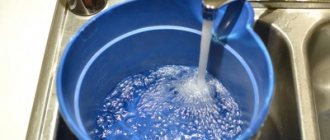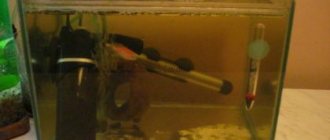Home/AQUARIUM SETUP/Shells in the aquarium: processing, placement, selection
An aquarium in any style will be a wonderful decorative element for any room. Today, marine options are gaining popularity, where you can place natural corals, launch unusual bright fish, and add seashells. Freshwater aquariums do not lose their relevance; they delight with a riot of greenery, beautiful fish, and a bizarre bottom landscape.
Rules for processing shells
Before immersing shells in water, you need to check whether they are empty; those who lived there previously must “leave” their shelter. If a specimen is valuable to the owner or his family, there is no need to put it in to decorate the aquarium, since the surface of the shells can change texture, color, and even dissolve in tap water.
Shells found on the sea coast cannot be immediately placed in an aquarium; they must be processed. First of all, we clean them with a stiff brush, then put them on the fire and simmer over low heat for three hours. After heat treatment, they must be placed in cold water for soaking for a day. To prevent the shells in the aquarium from harming the inhabitants, a procedure for their disinfection is carried out. In the natural environment, many microorganisms live on shellfish, including harmful bacteria.
Preparation
Having found a particularly lovely seashell on the shore, and eager to immediately put it in your home aquarium, you should not rush - first you need to process the future decoration as follows:
- First of all, they check whether the sink is empty - there should be no remains of the owner in it, otherwise pieces of flesh will decompose and poison the water in the tank. If the sink is not empty, it cannot be used.
- After making sure that the sink is free, it is brought home and thoroughly cleaned with a stiff brush, removing dirt and other build-up on the surface. Immediately after this, the shell is sent to boil over low heat for 3 hours to completely destroy bacteria and germs.
- Having finished with heat treatment, the hot shell is sent to a basin with cold water, where the future decoration is soaked for 24 hours. The disinfection procedure will save the lives of fish in the aquarium and eliminate the possibility of developing infections and poisoning the aquatic environment. Only after all the above manipulations can the shells be immersed in an artificial pond.
Sea or river shells are a simple and convenient way to decorate an aquarium and give the tank a natural look. However, before using shells, you should make sure that their placement will not adversely affect aquatic flora and fish, and only then begin planning the design and selection of shells. In addition, it should be remembered that shells found in the wild must be carefully processed before diving, otherwise the owner risks the life of small pets.
Criteria for selecting seashells
In some cases, you can place two or three shells in an aquarium, if you take into account its features. Some fish adapt them as a house, others as a place where they lay eggs. In these cases, you need to add several beautiful specimens, observing the following rules:
- Do not use aquarium shells with sharp elements, corners or protrusions as decoration. Touching such surfaces can cause injury to underwater inhabitants;
- The entrance to the internal cavity should not be visible; shells are placed only with the blank surface up, otherwise small fish may swim inside and will not be able to get out, and will eventually die;
- Aquarium shells must be thoroughly cleaned, and painted or varnished specimens should not be used;
- Do not put valuable species, they will change or dissolve;
- The previous inhabitant must be absent, if there are pieces of flesh left inside, they will begin to rot.
How to Place Shells in Neptune's Realm
It will not work to haphazardly dump shells on the bottom of the aquarium; such “wealth” will not create beauty; their placement should be played up, and accessories should be prepared in different versions. The underwater landscape will look great if among the shells you can see the skeletons of sunken ships, partially destroyed castles, flooded with water. You can plant seaweed in a few flat shells to avoid using plastic containers.
The shells can be miniature, then it is more expedient to simply scatter them in a layer over the entire bottom of the aquarium, and put two or three larger pieces in one of the corners. A saltwater aquarium differs from a freshwater one only in that it is not created so often by amateurs. Shells at the bottom of a marine aquarium create a unique look; underwater plants were not originally intended for this kingdom, so calcium decorative elements will not cause any harm to anyone.
You cannot be guided only by the idea of design; the practical component is important, since the shell consists of the same element as chalk and limestone, that is, it is 100% calcium carbonate. This is precisely what becomes the main criterion when aquarists bypass this design option for the underwater world.
Advantages and disadvantages
Of course, aquarium shells are considered one of the most beautiful and natural decorative elements that can transform an artificial pond and bring a lot of benefits to small underwater inhabitants. However, in addition to the undeniable advantages, placing shells also has disadvantages that you should know about in advance.
The advantages of using shells in a saltwater or freshwater aquarium include the following:
- Decorate a pond - shells, correctly combined with other decorations, can give the aquarium a natural and bewitching look, allowing the owner to enjoy an amazing spectacle.
- They compensate for the lack of calcium - at their core, shells are calcium carbonate, which is necessary for mollusks and fish to form bones, shells and scales.
- Serve as a shelter - seashells can be used not only as decoration, but also as shelter for certain types of fish. There are more disadvantages to shells than advantages, but knowledge of them will help the aquarist to neutralize dangerous factors and put seashells into the tank without sad consequences:
- They increase water hardness - if there are fish in the aquarium that prefer soft and slightly acidic water, then in such an environment the shells will quickly dissolve, increasing the hardness levels. In this case, placing sinks is not recommended. If the water in the tank is initially hard, then the shells will not cause any harm.
- They cause injuries and cuts - if the shells placed in the aquarium have sharp edges, the fish can cut themselves or injure their delicate fins. In addition, it is possible that a curious fish will climb inside the shell and not be able to get out, so it is recommended to place these elements with the entrance hole down.
- Toxicity - this flaw is characteristic of those shells that were purchased in souvenir shops. The fact is that in such places of sale, shells are covered with a layer of varnish and paint to make the products look better, and when placed in an aquarium, they begin to release harmful substances into the water. To avoid sad consequences, shells should be purchased at pet stores.
What happens to water when shells are submerged?
When calcium carbonate is placed in an aquarium, it begins to affect the acid-base balance of water, hardness indicators, and it is impossible to do without taking these circumstances into account, because fish react to the water composition, different species differently. If the water in the aquarium is soft and has low acidity, shellfish shells are absolutely inappropriate there, since they will have a negative effect on the fish, especially for individuals of the Characin family.
Water that has such hardness and softness is able to quickly dissolve calcium, so the chemical composition of the water will begin to change quickly. Fish of the specified family will survive, but will stop reproducing. Aquarium plants sense the slightest changes in the acidity and hardness of water no less than fish. Given the consequences, before choosing places on the bottom where you should put shells, you need to think about whether they are needed there at all?
If the water is of medium hardness, slightly alkaline, you can put a small amount of shellfish shells into the tank; they will not be able to significantly affect the composition of the water, which means they will not cause harm. The water pH is very important; a specific one is suitable for each type of fish, so it should be maintained so that the underwater inhabitants are healthy and feel good. Before immersing the sinks in water, it is advisable to test it, after which it will become clear whether the bottom can be decorated.
Before creating a unique underwater world in your apartment, you should think about whether it is possible and necessary to use shells? When creating a freshwater aquarium, they are usually not required. Before you buy the necessary accessories and underwater inhabitants, you need to think about what the final version will look like, what shells will be needed, how many of them will be needed, and only after that start decorating the interior.
Watch a video about adding shells to an aquarium
AdminAuthor of the article
Did you like the article?
Share with your friends:
Aquariums Biodesign
An aquarium is a mini-underwater world that brings people not only pleasant emotions, but also incredible benefits! We told you about the benefits of an aquarium here: //biodesign.by/polza-ot-akvariuma-vliyanie-akvariuma-na-zdorove-mikroklimat-i-dr.html
We all know how underwater life can fascinate with its uniqueness and beauty. Therefore, everyone strives not only to populate their aquarium with fish, but also to give it an aesthetic appearance through decoration.
You can decorate an aquarium in many ways, using various materials, such as: various soils, pebbles, plants, driftwood, castles, ships and much more. The most popular design for many aquarists is the shell design, which blends naturally into the underwater environment and can be easily combined with other aquarium materials.
Can you put shells in an aquarium?
Every aquarist faces an acute question: is it possible to place shells in an aquarium? After all, it is known that shells in an aquatic environment tend to dissolve, releasing calcium carbonate, of which they consist almost 100%. And calcium carbonate, in turn, affects water hardness and its pH. And some species of fish (Characins do not spawn in it) and plants take water hardness very seriously.
However, we confidently declare that shells can be placed in an aquarium! Why?
- The first argument for this is a rhetorical question: if you cannot place shells in an aquarium, then why is this such a popular way of decorating an aquarium that even experienced aquarists do not disdain?
- Shells dissolve very slowly, and a small amount of shells may not have much impact on the aquatic environment, especially if you are using a larger aquarium. Here’s a quick question: you’re not going to fill the aquarium halfway with shells, or even more, are you?
- The use of shells in the design of an aquarium, as we have already said, depends on what types of fish will live in your underwater world. Many species are cool with hard water.
- Can you put shells in an aquarium? What would you say about those types of fish for which shells in the aquarium are vital? Yes, some species of aquatic life use shells for spawning or as shelter. Is it possible to refuse them this?
- You should also consider what the initial parameters of the water you use for the aquarium are. If the water hardness is initially higher, the less influence the shells will have on it. If the water is soft, slightly acidic, then the shells will dissolve more intensely.
So, we hope that you are convinced that it is possible, and sometimes even necessary, to place shells in an aquarium. However, we advise you to follow some rules:
- The process of dissolving shells is accelerated by the addition of pH-lowering agents and the supply of carbon dioxide. Therefore, try not to combine the first and second.
- Do not place shells in the aquarium that can injure fish (those with sharp protrusions and edges).
- Try to place shells in the aquarium with the entrance facing down so that curious fish do not get stuck in them, which leads to death. This advice especially applies to you if you keep catfish in your aquarium. Conversely, neglect this advice for those species of fish that use shells for their own purposes (housing, safety, spawning).
- You can put shells in the aquarium that are not treated with varnish or paint!
- We also do not recommend that you put in the aquarium those types of shells that are of high value and dear to you personally, because they can dissolve in water and change their color and texture.
In any case, if you really want to decorate an aquarium with shells, but have seen any contraindications to this, do not despair! After all, you can decorate an aquarium both inside, by placing shells in the water, and outside, next to the aquarium. Sometimes this can make your aquarium design even more charming and stylish!
Are you choosing shells? Then read how to choose them correctly and prepare them for use.
We, in turn, are pleased to offer you colorful sets of shells and starfish in a basket at competitive prices:
(accepting orders by email - 24 hours a day)
You can view the terms of payment and delivery of goods here >>>>>
Look in your cart and place your order here >>>>>
Go to the main page of the online store - here >>>>>
Source: //biodesign.by/rakushki-v-akvariume.html










